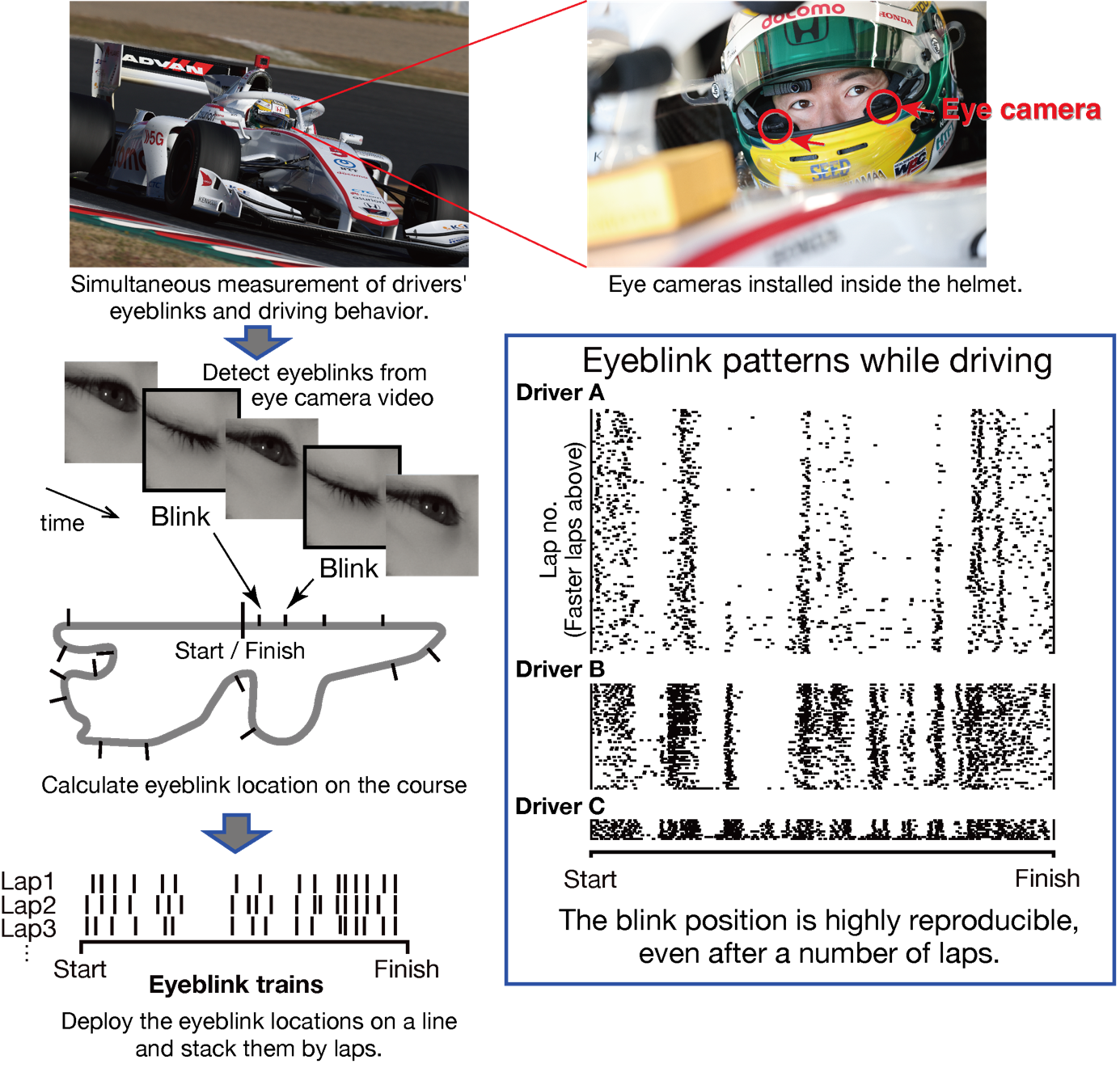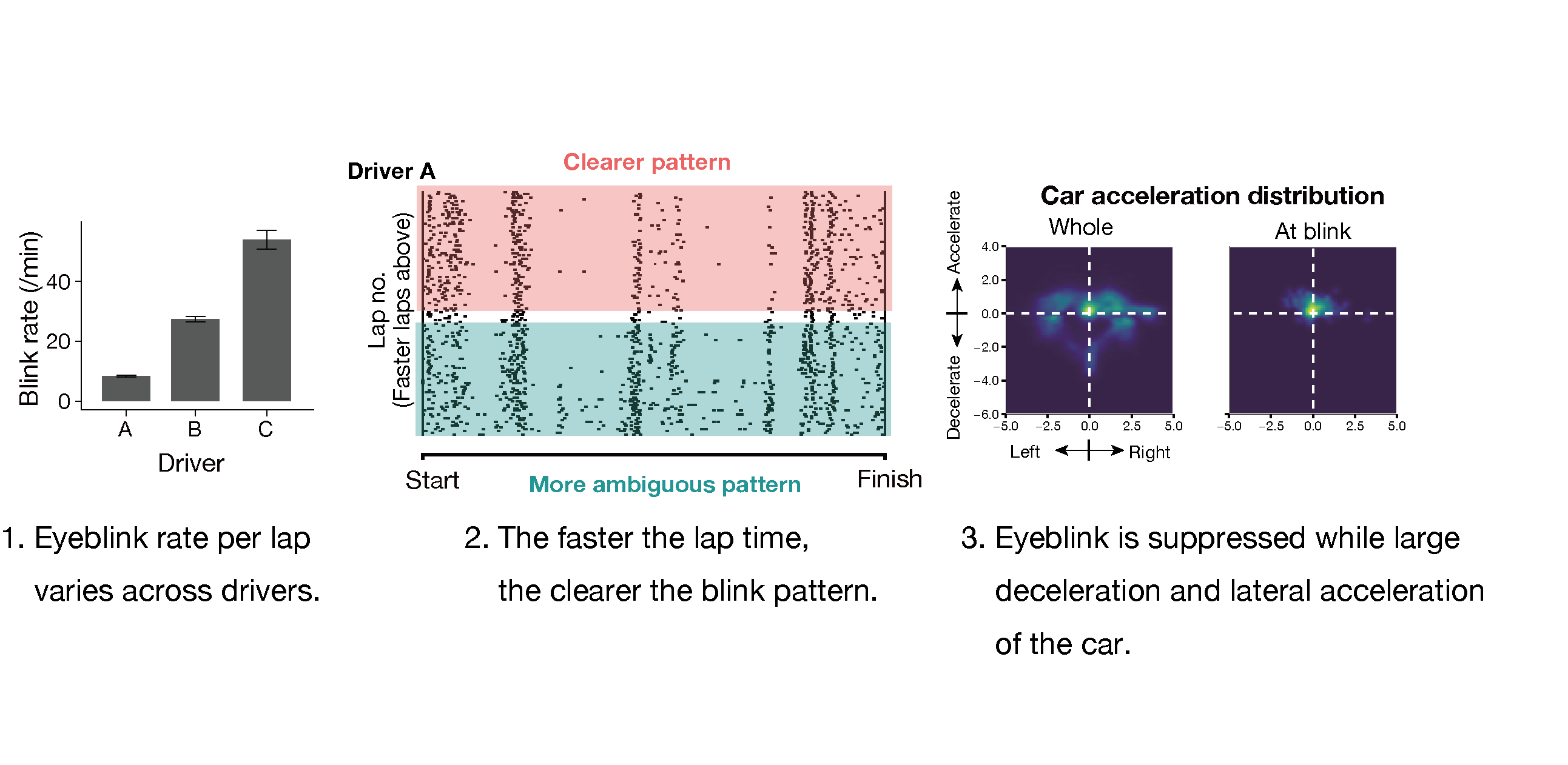Microsoft ends support for Internet Explorer on June 16, 2022.
We recommend using one of the browsers listed below.
- Microsoft Edge(Latest version)
- Mozilla Firefox(Latest version)
- Google Chrome(Latest version)
- Apple Safari(Latest version)
Please contact your browser provider for download and installation instructions.
May 20, 2023
World's First Discovery of Highly Reproducible Eyeblink Patterns in Formula Car Drivers
Pioneering a Method for Reading the Cognitive State of Humans in Action in a Real Environment
NTT Corporation (NTT; Head Office: Chiyoda-ku, Tokyo; President and CEO: Akira Shimada; hereafter "NTT") and Dandelion Ltd. have demonstrated for the first time in the world that Formula car drivers exhibit reproducible eyeblink patterns on a course during real Formula car driving. The study revealed that drivers' physiological factors and changes in the cognitive state associated with driving behavior are behind this eyeblink pattern. This indicates that the eyeblink pattern during natural behavior is an essential biomarker for reading the cognitive state of humans in-the-wild and will contribute to the digital expression of one's mind and the transmission of advanced skills toward creating a human digital twin (*2).
This research was conducted in cooperation with DOCOMO TEAM DANDELION RACING (*1), a car racing team operated by Dandelion Ltd., and was elucidated through direct observation of the eyeblink of professional racing drivers who actually drove high-speed laps around a race circuit.
The details of this research were published online in the American scientific journal "iScience" on May 19, 2023 EST.
1. Research background
NTT Communication Science Laboratories is performing research to gain a deeper understanding of the brain mechanisms that control the body and mind with the aim of realizing a society where everyone can fully demonstrate their unique abilities. Top athletes who display outstanding skills and mental abilities in competitions are one of the most intriguing subjects for such research. However, since it is difficult for the athletes themselves to recognize the brain functions underlying their performance, it is necessary to observe their performance in a real environment from multiple perspectives and conduct a series of scientific analyses in order to capture it. Therefore, cooperating with the DOCOMO TEAM DANDELION RACING, we examined the implicit brain function underlying superior driving skills by observing the physical and mental states of three top drivers competing in the All Japan Super Formula Championship (*2) while they drove Formula cars on a circuit.
How do racers blink while driving Formula cars? Although there have been numerous studies on where people look when driving a car, the presence of eyeblinks has yet to be addressed or is assumed to occur randomly. Spontaneous eyeblink occurs approximately 20 times per minute, with each blink resulting in a loss of approximately 0.2 seconds of visual information. In other words, even with proper gaze control, inappropriate eyeblink timing can significantly impact driving, especially for Formula car drivers competing for a split-millisecond difference in lap times.
2. Main findings
We measured the drivers' eyeblinks and driving behavior while driving Formula cars on a circuit during practice sessions (Fig. 1) and found that they blinked at surprisingly similar positions on the courses. The pattern was highly reproducible even after repeated laps (Fig. 1, bottom right).
 Figure 1. Eyeblink patterns during Formula car driving.
Figure 1. Eyeblink patterns during Formula car driving.
We also found that this eyeblink pattern was strongly related to (1) the driver's individual blink count, (2) lap pace, and (3) car acceleration from front to back and left to right (Fig. 2). Despite the significant differences in blink frequency among drivers (Fig. 2, left), eyeblink locations on the course were similar among drivers and were biased toward times when vehicle acceleration was small (Fig. 2, right). Conversely, blink suppression was stronger when the vehicle was decelerating significantly or accelerating laterally. For example, the eyeblink was suppressed during the phase when the vehicle was rapidly decelerating from a speed of nearly 300 km/h and entering a corner, indicating that the blink occurred intensively as the vehicle exited the corner and headed into the next section. In other words, this result suggests that the steep change in the cognitive state during cornering is reflected in the suppression/occurrence of the eyeblink.
 Figure 2. Three factors determine eyeblink patterns while driving.
Figure 2. Three factors determine eyeblink patterns while driving.
3. Feature point
Thanks to the close collaboration between NTT Communication Science Laboratories and the top racing team, we were able to achieve the simultaneous measurement of car behavior and the driver's eye metrics. Our findings demonstrate that it is possible to capture changes in human cognitive and psychological states through eyeblink patterns even under the extremely harsh environment of driving a Formula car at nearly 300 km/h.
Although there have been conventional attempts to read out one's cognitive and psychological states through eye metrics such as gaze behavior, pupil diameter change, microsaccade, etc., these indicators are sometimes too delicate to measure during in-the-wild natural behavior. In contrast, the eyeblink can be clearly captured under extremely harsh conditions such as during Formula car driving, which is subject to severe vibration and large changes in the lighting environment. Our findings will open up new pathways for examining cognitive state change under natural behavior.
4. Research outlook
NTT has advocated digital twin computing (*3) as part of the IOWN concept (*4) and is currently conducting research and development related to this technology. The results of this research will be utilized to develop a mind-reading technology to estimate the inner state of humans from the information that appears on the body surface. We also aim to elucidate the implicit brain functions underlying the extremely advanced skills of humans. Our research will contribute to enabling the digital expression of human consciousness and thoughts and link them to skill improvement and skill transmission through their digital expression.
5. Publication information
Nishizono, R., Saijo, N., and Kashino, M. (2023). Highly reproducible eyeblink timing during Formula car driving. iScience DOI: 10.1016/j.isci.2023.106803
https://www.cell.com/iscience/fulltext/S2589-0042(23)00880-5
Glossary
*1DOCOMO TEAM DANDELION RACING
https://www.dandelion-racing.com/team/
*2All Japan Super Formula Championship
Japanese top Formula racing series. Along with the Indy Car series in the USA, it is the fastest racing series in the world after Formula One.
*3NTT R&D Website: What is Digital Twin Computing? https://www.rd.ntt/e/iown/0003.html
*4NTT R&D Website: "What's IOWN?"https://www.rd.ntt/e/iown/0001.html
For media inquiries regarding this matter, please contact
Public Relations Office
NTT Science and Core Technology Laboratory Group
nttrd-pr@ml.ntt.com
Information is current as of the date of issue of the individual press release.
Please be advised that information may be outdated after that point.
NTT STORY
WEB media that thinks about the future with NTT










